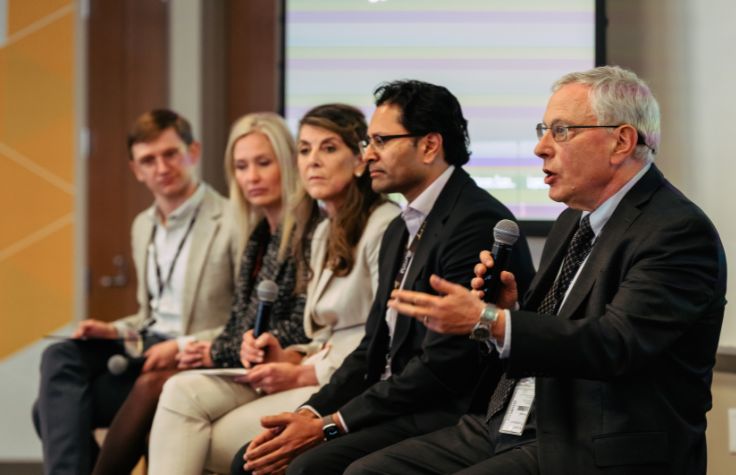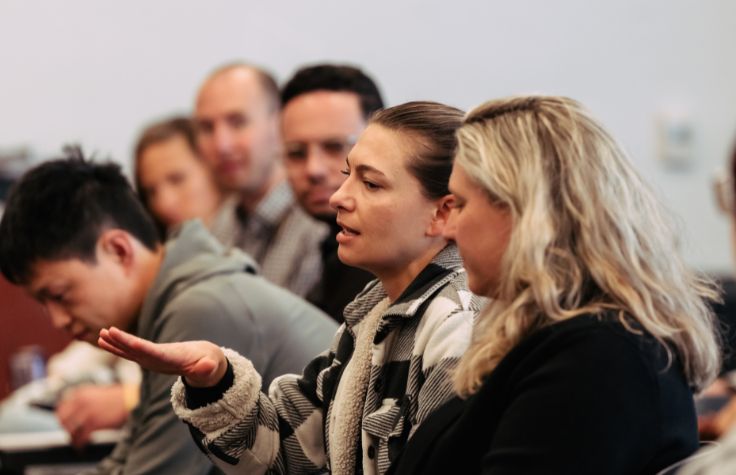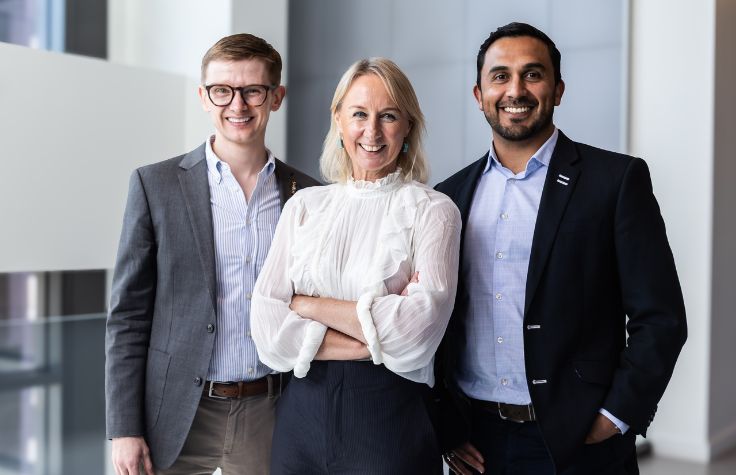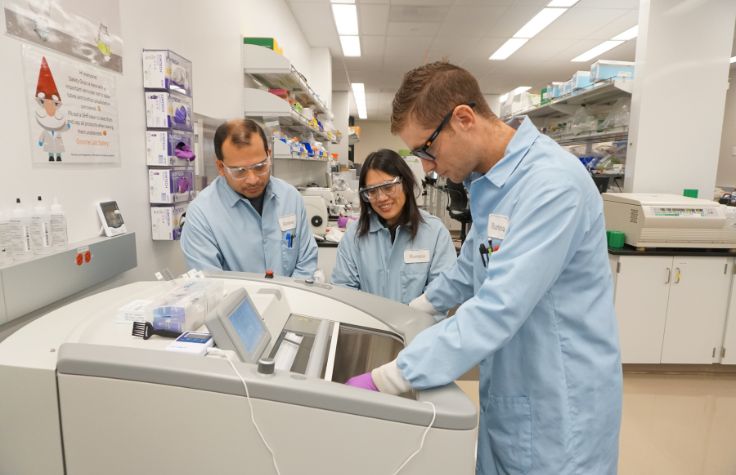
14 April 2025
When Lainey Moseley’s daughter Leta was born 27 years ago, the doctors knew she had a severe disability, but they could provide no diagnosis. “We were told good luck, and sent home with no road map, community, or any understanding of what the future might look like. It was the dark ages of genetic medicine,” Lainey said at a recent event at Illumina’s headquarters in San Diego. The company hosted a screening and panel for her documentary, Rare: A Rare Disease Revolution.
Lainey went on to explain that for the first ten years of her daughter’s life, she spent at least three months of every year in the hospital. The only diagnosis they had until Leta was 18 years old was “pervasive developmental delay of unknown etiology.” But as the field of genomics advanced and genetic testing became available to a growing number of patients, the Moseleys finally got their answer through exome sequencing. Leta was the first person in the world to be diagnosed with an ultra-rare condition now called CHOPS syndrome, short for cognitive impairment, heart defects, obesity, pulmonary involvement, and skeletal dysplasia.
In 2016, Lainey founded CHOPS Syndrome Global to raise money for research and connect families around the world. She explained that for rare disease families, having a diagnosis changes everything. Using their genomic diagnosis, patients and family members can find other families, build community, and share tips and lessons learned with people who intimately understand their daily challenges. She now has a community of 45 families with a child diagnosed with CHOPS, whereas for the first two decades of Leta’s life, the Moseleys were alone. She said, “It’s still ultra rare, but having community is the foundation for advocacy—and advocacy leads to finding ways to accelerate research and treatment. None of this momentum happens until there’s a diagnosis.”

Lights, camera, advocacy!
During the pandemic, Lainey, a former television news producer for CBS and NBC, decided to recognize the many “rare” families she’d met through her own foundation advocacy, many of whom were benefiting from genomics in ways that at first surprised her. “What struck me about this generation of rare disease families was that they all have something that I didn’t have—they have hope,” she said. “They have hope for potential treatments and even cures for their kids.”
People are often surprised to learn there are more than 6000 known rare diseases, affecting an estimated 300 million individuals around the world, including up to 10% of the US population. “Yeah, individually each of these conditions are rare, but collectively they impact a significant portion of the population,” Lainey told Illumina. “These are kids—often very sick—who historically have gone undiagnosed altogether or their parents were given a symptom, say epilepsy, that became the de facto diagnosis. I felt it was important to make this film to celebrate these parents for driving the science and fighting for something that wasn’t possible when my daughter was born.”
The film follows several families as they navigate the challenging journey from noticing symptoms in their child to receiving a diagnosis—what is often called the “diagnostic odyssey” and takes, on average, six to eight years. It captures their emotional process of understanding the realities and future scenarios for their child while simultaneously searching for a treatment or cure.
The film also highlights how families affected by rare diseases are creating new systems and pathways for research because existing ones were not meeting their needs. For example, pharmaceutical companies and government agencies tend to invest in research and development for therapies that will help the most people, not a handful of individuals. Furthermore, randomized clinical trials are extremely challenging to conduct for conditions with small patient populations, making it difficult to show the statistical significance needed to secure regulatory approval. And even though rare parents are generally eager partners who are willing to try experimental therapies—often because no alternatives exist—they lack the support needed to make these connections. Left with no options, some rare parents are doing the work themselves: coordinating patients and families, finding scientists willing to study them, fundraising for research, advocating on Capitol Hill (in the US), and more.
Lainey interviewed a range of experts, including CEOs, lab directors, physicians, and parents. These experts described how rare families are pushing the science in ways unheard of in other conditions. Creating a gene therapy that targets a specific condition, for example, requires a dedicated scientific team, millions of dollars, many years, and someone to commit thousands of hours to managing the project and keep it moving forward. Most of all, it requires someone—often a parent—to dare to imagine that it’s even possible.
Amber Freed, mother of Maxwell and founder of SLC6A1 Connect, quit her “dream job” to find scientists who might spark hope where the doctors couldn’t. In the film, Amber takes her son to a fundraising event at a local school. She describes having planned charity fundraisers, hosted multiple symposia, raised $5 million, and repurposed a drug, among other things. “Action is our coping mechanism,” Amber says.
Amber, who also sat on the Rare event panel and expressed her gratitude for Illumina employees’ work, speaks in the documentary about her anxiety and uncertainty. She feels pressure to make something happen, not just for her son but for the entire community of patients. “We’re in a fight against time,” she says, explaining that within a year her son could suffer irreversible harm to his neurological system. “I’m not going to stop until my miracle happens. Even though they tell us there is no treatment […] at the end of the day, doing everything I can is the only way I can look at my beautiful little boy in the eyes and tell him I left no stone unturned.”

Creating a movement
At the screening, Rare: A Rare Disease Revolution brought many employees to tears. The panel afterward gave them the chance to ask directly about the experience of navigating the health care system as a parent, advocating for more comprehensive newborn screening, and making diagnoses with whole-genome sequencing. Illumina Patient Advocacy Specialist Cody Barnett planned the event and led the panel discussion. “We are at an inflection point where truly personalized therapies, made possible by genomics, are becoming a reality,” Barnett said. “The question is no longer ‘can this be done,’ it’s ‘how do we do it at scale so everyone who could benefit, does.’ Lainey’s film shows the extraordinary lengths parents are going to to answer these questions. I’m thrilled that our scientists, engineers, and other teammates were able to see the impact of their work and understand why what we do every day is fueling this movement.”
Lainey Moseley made the film primarily for people who may not understand rare disease, who dismiss it, or who don’t know how to act around somebody living with one. “Rare families don’t want people’s pity,” she said. “We want you to lean into the movement, acknowledging that we are not ‘too rare to care,’ because it impacts all our lives. The lessons being learned in rare disease today will benefit everyone tomorrow. Rare really does inform common. We cannot be overlooked or forgotten anymore.” ◆
To learn more, go to tooraretocare.com or contact Lainey Moseley at ARareDocumentary@gmail.com for information about scheduling a screening.


